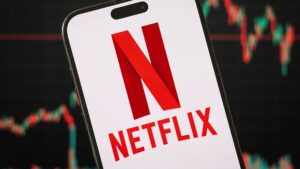Netflix’s Record Streak: What Investors Need to Know
In the ever-evolving landscape of streaming services, Netflix (NFLX) is currently riding a remarkable wave of success. The streaming giant has achieved an unprecedented milestone, trading for 11 consecutive days without a decline, marking its longest positive streak to date. This exciting development has sparked renewed interest among investors and industry watchers alike, setting Netflix apart in a turbulent market.
Historical Performance: A Benchmark for Investors
To put this achievement into context, it’s worth noting that Netflix’s previous record stood at nine days, a streak accomplished in late 2018 and early 2019. During that period, the stock fluctuated, but ultimately, the new 11-day run solidifies Netflix’s position as a resilient player in the streaming market, particularly as it approaches all-time high levels since its IPO in May 2002.
This milestone follows Netflix’s recent earnings report on April 17, revealing a 13% increase in revenue during Q1 2025, fueled by higher-than-expected subscription and advertising income. While traditional media stocks have faced headwinds from economic pressures, Netflix’s robust performance is both impressive and indicative of its strong market position.
Why Netflix Stands Out in a Challenging Market
Unlike many of its traditional media counterparts, such as Warner Bros. Discovery and Disney, which have seen losses of 10% and 13% respectively since President Trump’s second term began, Netflix has largely weathered the storms caused by trade wars and economic downturns. Its status as a go-to entertainment option suggests that consumers are less likely to abandon subscriptions during tough economic times, a sentiment echoed by Netflix’s co-CEO Greg Peters.
Future Outlook: Opportunities Ahead
Looking ahead, Netflix maintains a full-year revenue forecast between $43.5 billion and $44.5 billion. The company emphasizes that its overall business outlook remains strong, with no significant changes anticipated due to external pressures, such as tariffs. Peters notes that historically, entertainment remains resilient in challenging economic climates, adding further confidence to investors.
Furthermore, analysts at JPMorgan reaffirmed their bullish stance, indicating that Netflix is "the clear leader in global streaming" and poised to capitalize on upcoming Advertising Upfronts in May, which could serve as a positive catalyst for the stock.
Pricing Strategies: Assessing Stakeholder Reactions
Netflix has adjusted its pricing tiers, positioning the standard plan at $17.99, an ad-supported tier at $7.99, and a premium package at $24.99. While some may worry about subscriber growth stagnation—especially since Netflix has ceased publicly disclosing membership figures—the company’s revenue-focused strategy appears to be resonating well with consumers.
Conclusion: The Netflix Advantage
For investors and stakeholders looking to make informed decisions, Netflix encapsulates a model of resilience and strategic adaptability. As traditional media faces increasing pressure, Netflix’s steady growth trajectory and innovative pricing strategies reinforce its position as a worthwhile investment.
By keeping a finger on the pulse of both industry trends and Netflix’s evolving business model, readers of Extreme Investor Network will find themselves well-equipped to navigate the exciting landscape of streaming entertainment. Stay tuned for our upcoming analysis and insights as we continue to track Netflix’s performance in this dynamic market!

